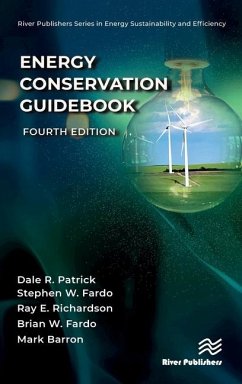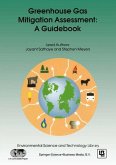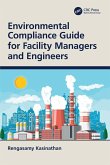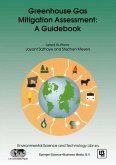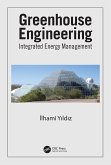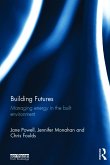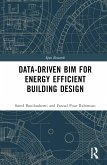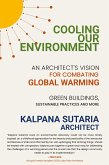- Gebundenes Buch
- Merkliste
- Auf die Merkliste
- Bewerten Bewerten
- Teilen
- Produkt teilen
- Produkterinnerung
- Produkterinnerung
This book provides a very practical discussion of how energy can be managed and saved in most types of buildings.
Andere Kunden interessierten sich auch für
![Greenhouse Gas Mitigation Assessment: A Guidebook Greenhouse Gas Mitigation Assessment: A Guidebook]() Jayant A. SathayeGreenhouse Gas Mitigation Assessment: A Guidebook81,99 €
Jayant A. SathayeGreenhouse Gas Mitigation Assessment: A Guidebook81,99 €![Environmental Compliance Guide for Facility Managers and Engineers Environmental Compliance Guide for Facility Managers and Engineers]() Rengasamy KasinathanEnvironmental Compliance Guide for Facility Managers and Engineers71,99 €
Rengasamy KasinathanEnvironmental Compliance Guide for Facility Managers and Engineers71,99 €![Greenhouse Gas Mitigation Assessment: A Guidebook Greenhouse Gas Mitigation Assessment: A Guidebook]() Jayant A. SathayeGreenhouse Gas Mitigation Assessment: A Guidebook81,99 €
Jayant A. SathayeGreenhouse Gas Mitigation Assessment: A Guidebook81,99 €![Greenhouse Engineering Greenhouse Engineering]() Ilhami YildizGreenhouse Engineering253,99 €
Ilhami YildizGreenhouse Engineering253,99 €![Building Futures Building Futures]() Jane PowellBuilding Futures238,99 €
Jane PowellBuilding Futures238,99 €![Data-driven BIM for Energy Efficient Building Design Data-driven BIM for Energy Efficient Building Design]() Saeed BanihashemiData-driven BIM for Energy Efficient Building Design206,99 €
Saeed BanihashemiData-driven BIM for Energy Efficient Building Design206,99 €![Cooling our Environment Cooling our Environment]() Kalpana SutariaCooling our Environment18,99 €
Kalpana SutariaCooling our Environment18,99 €-
-
-
This book provides a very practical discussion of how energy can be managed and saved in most types of buildings.
Hinweis: Dieser Artikel kann nur an eine deutsche Lieferadresse ausgeliefert werden.
Hinweis: Dieser Artikel kann nur an eine deutsche Lieferadresse ausgeliefert werden.
Produktdetails
- Produktdetails
- Verlag: River Publishers
- 4. Auflage
- Seitenzahl: 524
- Erscheinungstermin: 14. Dezember 2023
- Englisch
- Abmessung: 240mm x 161mm x 33mm
- Gewicht: 945g
- ISBN-13: 9788770229579
- ISBN-10: 8770229570
- Artikelnr.: 68712064
- Herstellerkennzeichnung
- Libri GmbH
- Europaallee 1
- 36244 Bad Hersfeld
- gpsr@libri.de
- Verlag: River Publishers
- 4. Auflage
- Seitenzahl: 524
- Erscheinungstermin: 14. Dezember 2023
- Englisch
- Abmessung: 240mm x 161mm x 33mm
- Gewicht: 945g
- ISBN-13: 9788770229579
- ISBN-10: 8770229570
- Artikelnr.: 68712064
- Herstellerkennzeichnung
- Libri GmbH
- Europaallee 1
- 36244 Bad Hersfeld
- gpsr@libri.de
Dale R. Patrick served as a Professor in the Department of Applied Engineering and Technology at Eastern Kentucky University. His experience includes teaching and organizing laboratory classes in electrical engineering/electronics technology for many years. He completed Bachelor of Science and Graduate Degrees at Indiana State University. His experience also includes research projects, technical teacher training, and energy consulting for business and industry. He and Dr. Fardo have co-authored over 30 textbooks and laboratory manuals. Stephen W. Fardo is currently a Foundation Professor in the Department of Applied Engineering and Technology at Eastern Kentucky University. His experience includes teaching and organizing laboratory classes in electrical engineering/electronics technology for many years and coordinating/advising technical teacher programs for the State of Kentucky. He completed Bachelor of Science, Master of Science and Doctoral Degrees at Eastern Kentucky University and University of Kentucky. His experience also includes research projects, technical teacher education, and energy consulting for business and industry. He and Dale Patrick have co-authored over 30 textbooks and laboratory manuals. Ray E. Richardson is currently is a Professor in the Department of Applied Engineering and Technology at Eastern Kentucky University. His experience includes teaching and organizing lecture and laboratory classes in electrical engineering/electronics technology since 1985 as well as teaching technical seminars, technical writing, and classes in the graduate program. He completed Bachelor of Science and Master of Science Degrees at Eastern Illinois University, and doctorate level at the University of Illinois. He is a certified Technology Manager at the Senior level by ATMAE. Other experience includes research projects in technical education and consulting in the manufacturing, food, and electronics areas. Brian W. Fardo served as an Adjunct Professor in the Department of Applied Engineering and Technology and the Noel Studio for Academic Creativity at Eastern Kentucky University. His experience includes teaching classes in applied creative thinking, electrical systems, materials and processes, transportation, manufacturing, construction, engineering graphics, and quality control. He has a B.Sc. Degree in Industrial Distribution and Logistics, an M.Sc. in Technology Systems from East Carolina University, and an M.Sc. in Career and Technical Education Eastern Kentucky University. He has completed coursework for a Doctoral Degree in Engineering/Technology Education at North Carolina State University. He currently owns and operates a telecommunications business. Mark Barron is an environmental and sustainability project manager with CBRE. Mr. Barron has been involved with HVAC and building management systems since 1998. He has been an Association of Energy Engineers certified energy manager since 2016. He completed Bachelor of Science and Master of Science degrees at Eastern Kentucky University.
1. Introduction
Green Energy Concept 2. Energy Basics
Foundation for Understanding 3. The Building Structure
Saving Money 4. Comfort Heating Systems
Saving Natural Resources 5. Summer Air Conditioning Systems
Saving Natural Resources 6. Lighting Systems
Improved Efficiency 7. Water Systems
Saving Our Valuable Resource 8. Electrical Power Systems
Improved Efficiency 9. Solar Energy Systems 10. Instrumentation and Measurement 11. Energy Management
For Going Green 12. Renewable Energy Systems 13. Energy Cost Reduction
Going Green 14. Appendix: Basic Electrical Symbols
Green Energy Concept 2. Energy Basics
Foundation for Understanding 3. The Building Structure
Saving Money 4. Comfort Heating Systems
Saving Natural Resources 5. Summer Air Conditioning Systems
Saving Natural Resources 6. Lighting Systems
Improved Efficiency 7. Water Systems
Saving Our Valuable Resource 8. Electrical Power Systems
Improved Efficiency 9. Solar Energy Systems 10. Instrumentation and Measurement 11. Energy Management
For Going Green 12. Renewable Energy Systems 13. Energy Cost Reduction
Going Green 14. Appendix: Basic Electrical Symbols
1. Introduction
Green Energy Concept 2. Energy Basics
Foundation for Understanding 3. The Building Structure
Saving Money 4. Comfort Heating Systems
Saving Natural Resources 5. Summer Air Conditioning Systems
Saving Natural Resources 6. Lighting Systems
Improved Efficiency 7. Water Systems
Saving Our Valuable Resource 8. Electrical Power Systems
Improved Efficiency 9. Solar Energy Systems 10. Instrumentation and Measurement 11. Energy Management
For Going Green 12. Renewable Energy Systems 13. Energy Cost Reduction
Going Green 14. Appendix: Basic Electrical Symbols
Green Energy Concept 2. Energy Basics
Foundation for Understanding 3. The Building Structure
Saving Money 4. Comfort Heating Systems
Saving Natural Resources 5. Summer Air Conditioning Systems
Saving Natural Resources 6. Lighting Systems
Improved Efficiency 7. Water Systems
Saving Our Valuable Resource 8. Electrical Power Systems
Improved Efficiency 9. Solar Energy Systems 10. Instrumentation and Measurement 11. Energy Management
For Going Green 12. Renewable Energy Systems 13. Energy Cost Reduction
Going Green 14. Appendix: Basic Electrical Symbols

